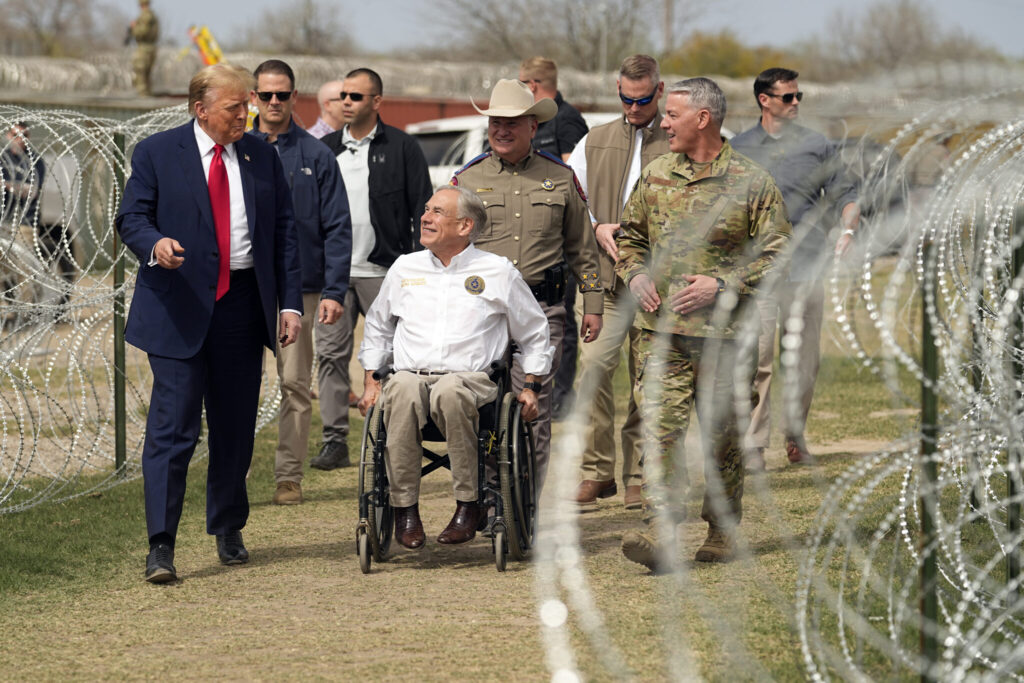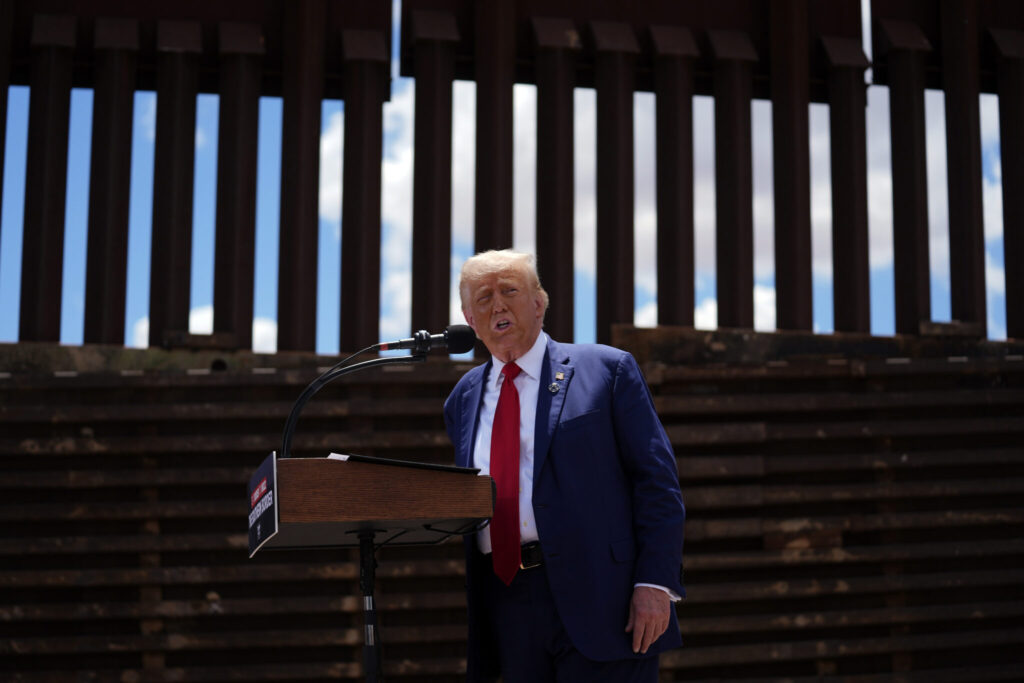Trump deportation strategy/ Trump’s immigration policy 2024/ Trump deportation plan/ Newslooks/ SAN DIEGO/ J. Manour/ Morning Edition/ Donald Trump is outlining bold new plans for mass deportations in his 2024 campaign, including invoking wartime powers and involving the military. While his previous deportation goals fell short during his presidency, Trump aims to use new strategies, including support from Republican governors. Despite legal challenges and logistical hurdles, Trump remains committed to these efforts in his bid for a second term.

Trump’s Deportation Plans Quick Looks:
- Trump outlines new mass deportation strategies for a potential second term
- Plans to invoke wartime powers and deploy National Guard for deportations
- Targeted use of like-minded Republican governors to enforce actions across states
- Legal and logistical challenges remain, including military reluctance and court rulings
- Past deportation numbers under Trump fell short of expectations
- Trump pledges to focus on criminals, drug dealers, and human traffickers
Trump’s 2nd Term Deportation Plans: Military, Governors & New Tactics
Deep Look:
Donald Trump is bringing fresh specifics to his 2024 presidential campaign, reviving a central promise from his first term: the mass deportation of millions of people living in the U.S. illegally. This time, Trump aims to invoke wartime powers, collaborate with Republican governors, and possibly involve the military to carry out what he promises will be the largest deportation effort in U.S. history.
During his presidency, Trump faced significant hurdles in achieving his deportation goals. His administration deported fewer than 350,000 people annually, far short of his pledge to remove millions. By contrast, the highest deportation number was under President Barack Obama, who removed 432,000 people in 2013. Despite this shortfall, Trump’s new strategy for a second term suggests a more aggressive and targeted approach.
Wartime Powers and Legal Tactics
One of the cornerstones of Trump’s new strategy is invoking the Alien Enemies Act of 1798, which allows the president to deport noncitizens from a country with which the U.S. is at war. Trump has indicated he would use this law to deport vast numbers of people by framing illegal immigration as a form of foreign aggression. Legal experts, however, say that while the use of this law is possible, it could face significant logistical and constitutional challenges.
Joseph Nunn, a counsel at New York University’s Brennan Center for Justice, commented that Trump’s plans might pass legal scrutiny but would likely face enormous practical challenges. “The military is not going to like doing it, and they are going to drag their feet as much as they can, but it is possible,” Nunn said, underscoring that while theoretically legal, the execution would be difficult.
Using Governors and National Guard Troops
Trump’s plan also involves like-minded Republican governors who could deploy their state’s National Guard to carry out deportation orders. Stephen Miller, Trump’s former senior policy adviser, has floated the idea that governors like Texas’ Greg Abbott could declare illegal immigration an “invasion” and use the National Guard to make arrests in neighboring states that refuse to cooperate.
For instance, Miller described a scenario in which Alabama’s National Guard could be sent into nearby Maryland to make arrests. This tactic would bypass state-level resistance in Democratic-leaning areas, though it would almost certainly face legal challenges and opposition from local authorities.
National Guard troops have historically been used at the U.S.-Mexico border for tasks like vehicle maintenance and surveillance, but Trump’s plan would expand their role significantly. Yet, military leaders might resist the order, seeing it as outside the normal scope of military duties and a potential blow to morale.
Overcoming Logistical Hurdles
While Trump’s strategy may sidestep some legal barriers, logistical issues remain substantial. Deportations are resource-intensive, requiring extensive background checks, coordination, and housing for detainees. U.S. Immigration and Customs Enforcement (ICE) currently has funding for only 41,500 detention beds, raising questions about where deportees would be held.
In previous attempts at mass deportations, ICE found that arrests were time-consuming and required careful planning. Former Homeland Security official John Sandweg noted that the reality of mass deportation would be nearly impossible to achieve, even with military involvement. ICE agents often spend hours on surveillance, and arrests without court warrants are difficult because targets do not have to allow officers into their homes.
Additionally, many of Trump’s deportation targets—such as Cuba, Venezuela, and Nicaragua—are slow or outright refuse to accept their citizens back, further complicating efforts. Under a 2001 Supreme Court ruling, people cannot be held indefinitely if there’s no reasonable expectation their home country will take them back, meaning extended detention would be legally problematic.
Political and Humanitarian Impact
Trump’s new mass deportation proposals would likely face considerable political opposition, not just from Democrats but also from some sectors of the Republican Party. The logistics of uprooting millions of people, many of whom have family members who are U.S. citizens, would create significant humanitarian concerns. Pew Research estimates that 70% of households with an undocumented member also include at least one legal resident, meaning deportations could tear families apart.
Moreover, mass deportations could exacerbate the country’s labor shortages, particularly in industries like agriculture, construction, and hospitality, which rely heavily on immigrant labor.
Trump acknowledged the political risks of his plan during a Sunday interview with journalist Sharyl Attkisson. “You put one wrong person onto a bus or onto an airplane and your radical left lunatics will try and make it sound like it’s the worst thing that’s ever happened,” he said. Nevertheless, he reiterated his commitment to removing what he described as “criminals, drug dealers, and human traffickers.”
The Power of Fear
Even if Trump’s mass deportation campaign does not achieve its full scope, the mere threat of widespread arrests and removals could have significant effects on immigrant communities. Adam Goodman, a historian at the University of Illinois who studies deportations, said that fear alone could be a powerful tool. In 2019, when Trump threatened mass deportations, ICE arrested only 35 of the 2,100 people targeted, but the announcement still sent waves of panic through immigrant communities.
While Trump’s goal of mass deportations may face legal, logistical, and political hurdles, the fear of such an operation could serve as a powerful deterrent, potentially driving immigrants further into the shadows.







